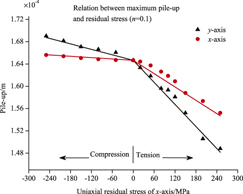Crossref Citations
This article has been cited by the following publications. This list is generated based on data provided by
Crossref.
Shen, Lei
He, Yuming
Liu, Dabiao
Wang, Meng
and
Lei, Jian
2016.
Prediction of residual stress components and their directions from pile-up morphology: An experimental study.
Journal of Materials Research,
Vol. 31,
Issue. 16,
p.
2392.
Wu, Jianjun
Wang, Mingzhi
Hui, Yu
Zhang, Zengkun
and
Fan, He
2018.
Identification of anisotropic plasticity properties of materials using spherical indentation imprint mapping.
Materials Science and Engineering: A,
Vol. 723,
Issue. ,
p.
269.
Peng, Guangjian
Lu, Zhike
Ma, Yi
Feng, Yihui
Huan, Yong
and
Zhang, Taihua
2018.
Spherical indentation method for estimating equibiaxial residual stress and elastic–plastic properties of metals simultaneously.
Journal of Materials Research,
Vol. 33,
Issue. 8,
p.
884.
Gao, Chenghui
and
Liu, Ming
2018.
Characterization of spherical indenter with fused silica under small deformation by Hertzian relation and Oliver and Pharr's method.
Vacuum,
Vol. 153,
Issue. ,
p.
82.
Zhang, Taihua
Cheng, Wenqiang
Peng, Guangjian
Ma, Yi
Jiang, Weifeng
Hu, Jiangjiang
and
Chen, Heng
2019.
Numerical investigation of spherical indentation on elastic-power-law strain-hardening solids with non-equibiaxial residual stresses.
MRS Communications,
Vol. 9,
Issue. 1,
p.
360.
Meng, L.
Breitkopf, P.
Raghavan, B.
Mauvoisin, G.
Bartier, O.
and
Hernot, X.
2019.
On the study of mystical materials identified by indentation on power law and Voce hardening solids.
International Journal of Material Forming,
Vol. 12,
Issue. 4,
p.
587.
Moharrami, R.
and
Sanayei, M.
2020.
Developing a method in measuring residual stress on steel alloys by instrumented indentation technique.
Measurement,
Vol. 158,
Issue. ,
p.
107718.
Meng, Liang
Zhang, Weihong
Quan, Dongliang
Shi, Guanghui
Tang, Lei
Hou, Yuliang
Breitkopf, Piotr
Zhu, Jihong
and
Gao, Tong
2020.
From Topology Optimization Design to Additive Manufacturing: Today’s Success and Tomorrow’s Roadmap.
Archives of Computational Methods in Engineering,
Vol. 27,
Issue. 3,
p.
805.
Coorevits, Thierry
Mejias, Alberto
Montagne, Alex
Kossman, Stephania
and
Iost, Alain
2020.
An integral approach of indentation of Functionally Graded Materials.
Surface and Coatings Technology,
Vol. 381,
Issue. ,
p.
125176.
Peng, Guangjian
Xu, Fenglei
Chen, Jianfeng
Wang, Huadong
Hu, Jiangjiang
and
Zhang, Taihua
2020.
Evaluation of Non-Equibiaxial Residual Stresses in Metallic Materials via Instrumented Spherical Indentation.
Metals,
Vol. 10,
Issue. 4,
p.
440.
Yuan, Lingxiao
Yuan, Weike
and
Wang, Gangfeng
2020.
Effects of Residual Stress on the Hardness of Elastoplastic Material Under Spherical Indentation.
Journal of Applied Mechanics,
Vol. 87,
Issue. 5,
Xu, Guo-Qiang
Luo, Yun
Yao, Bin
and
Jiang, Wenchun
2021.
Stresses measurement and failure prevention of on-line natural gas transmission pipelines for compressor station on collapsible loess area in northwest China.
Engineering Failure Analysis,
Vol. 126,
Issue. ,
p.
105467.
Zhou, Wei
Wang, Hong-bin
Wang, Quan
and
Huo, Qing-hui
2021.
Scratch resistance analysis of steel strip through nanoindentation method.
MRS Communications,
Vol. 11,
Issue. 6,
p.
936.
Liang, Tong
Yuan, Weike
and
Wang, Gangfeng
2021.
Influence of Equi-Biaxial Residual Stress on Spherical Indentation of Strain Hardening Materials.
International Journal of Applied Mechanics,
Vol. 13,
Issue. 05,
Burley, Max
Campbell, Jimmy E
Reiff-Musgrove, Rebecca
Dean, James
and
Clyne, Trevor William
2021.
The Effect of Residual Stresses on Stress–Strain Curves Obtained via Profilometry‐Based Inverse Finite Element Method Indentation Plastometry.
Advanced Engineering Materials,
Vol. 23,
Issue. 5,
Wang, Mingzhi
and
Wang, Weidong
2021.
An Inverse Method for Measuring Elastoplastic Properties of Metallic Materials Using Bayesian Model and Residual Imprint from Spherical Indentation.
Materials,
Vol. 14,
Issue. 23,
p.
7105.
Wang, Qiudong
Ji, Bohai
Fu, Zhongqiu
and
Xu, Zhaodong
2021.
Experimental study on the determination of welding residual stress in rib-deck weld by sharp indentation testing.
Thin-Walled Structures,
Vol. 161,
Issue. ,
p.
107516.
Jeong, Chanyoung
Hwang, Yewon
Kim, Naksoo
Lee, Cheolsoo
and
Lee, Hyungyil
2021.
Evaluation of equi-biaxial residual stress from spherical indentation imprint.
International Journal of Mechanical Sciences,
Vol. 211,
Issue. ,
p.
106773.
GUO, Jiang
FU, Haiyang
PAN, Bo
and
KANG, Renke
2021.
Recent progress of residual stress measurement methods: A review.
Chinese Journal of Aeronautics,
Vol. 34,
Issue. 2,
p.
54.
Zhou, Wei
Wang, Hong-bin
and
Huo, Qing-hui
2021.
Study on Indentation Response of Cold Rolled Strip Steel.
Journal of Materials Engineering and Performance,
Vol. 30,
Issue. 8,
p.
5931.
